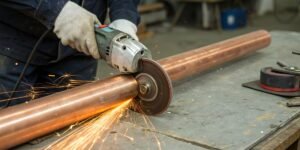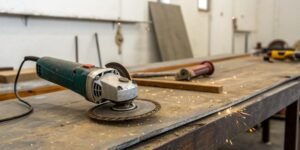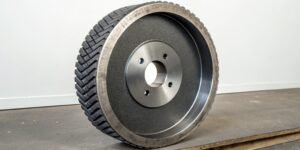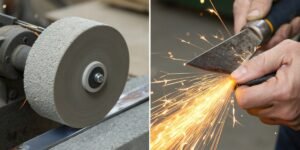
Picking up a disc that looks right but isn’t? This gamble can lead to a damaged grinder, a ruined workpiece, or worse, a disc shattering at high speed, turning a simple job into a serious safety hazard.
No, angle grinder discs are not fully interchangeable. [1, 2] For safe operation, the disc’s arbor size, diameter, and maximum RPM rating must all be compatible with the specifications of the angle grinder you are using. [1, 3]

My insight here comes from a core principle of our factory: safety through proper engineering. We produce discs to incredibly precise specifications for a reason. Using the wrong disc on a grinder is a recipe for disaster. It can damage the tool’s motor and bearings, destroy the disc itself, and create a significant risk of injury. As a B2B supplier, our responsibility isn’t just to sell a product; it’s to ensure our partners know how to use it safely and effectively. Different angle grinders need discs with different specifications.
Do all discs fit all angle grinders?
Do you assume any disc with the right-looking hole will fit your grinder? This common oversight is a major source of unsafe practices, leading operators to force discs or run grinders without their essential safety guards.
No. The disc’s diameter is just as important as the arbor (center hole) size. [4] Using a disc that is too large for the grinder’s guard is extremely dangerous and a leading cause of accidents. [4, 6]

Let’s break down the two critical measurements for a proper fit. First is the arbor size1, which is the diameter of the hole in the center of the disc. In North America, this is typically 7/8 inches, while in Europe and other regions it’s 22.23mm — these are actually the same size, so they are largely standardized. [4] The second, and more common issue, is the disc’s outer diameter. Grinders are built for specific disc diameter2s, such as 4.5", 5", 7", or 9". You simply cannot put a 9-inch disc on a 4.5-inch grinder. Forcing it by removing the safety guard is one of the most dangerous things an operator can do. Furthermore, the small grinder’s motor is not designed to handle the weight and rotational force of a large disc, leading to motor burnout3 and loss of control.
| Grinder Size | Common Max RPM | Compatible Disc Diameter |
|---|---|---|
| 4.5" (115mm) | 11,000 – 13,000 | 4.5" (115mm) |
| 5" (125mm) | 10,000 – 12,000 | 5" (125mm) |
| 7" (180mm) | 8,500 | 7" (180mm) |
| 9" (230mm) | 6,600 | 9" (230mm) |
Are angle grinder cutting discs universal?
Have you seen a disc labeled "universal" and thought it was safe for any tool? This marketing term can be dangerously misleading. It often refers only to the arbor fit, ignoring the most critical safety specification of all.
No, cutting discs are not universal because of their RPM rating. The RPM listed on the disc is a maximum safe speed. This number must be equal to or higher than the RPM of your grinder. [7, 8]

Let’s dive deeper into the physics of rotational speed, or RPM (Revolutions Per Minute). This is the number that keeps our safety engineers up at night. Smaller grinders spin much faster than larger ones. A 4.5" grinder might have a no-load speed of 11,000 RPM, while a large 9" grinder spins much slower, around 6,600 RPM. A 9" disc is built and tested only to withstand the centrifugal forces of that slower speed. If you were to mount that 9-inch disc on the small, fast grinder, you would be spinning it nearly twice as fast as its safety limit. The physical forces would build up until they overcome the disc’s internal bonding and reinforcement, causing it to explode. The term "universal" almost always just means it has the common 7/8" arbor hole. It does not mean it is universally safe. Always check the RPM rating.
Can I use a 4.5 inch disc on a 5 inch angle grinder?
You have a 5-inch grinder but only have 4.5-inch discs available. It seems like it should work, but is it a good idea? It’s a question of safety versus efficiency, and the answer is not always obvious.
Yes, you can safely use a 4.5-inch disc on a 5-inch grinder, as long as the arbor size fits and the disc’s RPM rating is higher than the grinder’s speed. [11] The main drawback is a significant loss in performance and cutting depth. [11, 12]

This is a scenario our technical team gets asked about often. From a safety standpoint, going down a size is usually acceptable. The smaller 4.5-inch disc is built to handle the higher RPMs of smaller grinders, so it will be well within the safety limits of a slightly slower 5-inch grinder. The arbor hole is the same. The real issue is performance, a key concern for our professional B2B clients. You immediately lose a quarter of an inch of cutting radius4, which means your total cutting depth5 is reduced. The disc will also wear out much faster relative to its size, leading to more frequent changes and lower overall productivity. While it’s possible in a pinch, it is not an efficient or cost-effective way to work. For professional results, you should always try to use the correct size disc for your grinder.
Can you change an angle grinder disc?
Is your cutting disc worn down to a nub but you feel hesitant to change it? Using a worn disc is slow, creates excess heat, and is a safety risk itself. Changing a disc is a basic skill every operator must know.
Yes, changing the disc is a fast and simple process. [15] First, unplug the grinder. Then, press the spindle lock button, and use the spanner wrench that came with the tool to loosen the flange nut and swap the disc. [15, 16]

This procedure should be second nature for any user. It’s designed to be straightforward. The first step is always the most critical: unplug the grinder from its power source. Never try to change a disc on a plugged-in tool. Next, locate the spindle lock button6, which is usually on the top of the grinder’s head. Pressing this button stops the shaft from spinning so you can get the nut loose. Now, use the spanner wrench that was supplied with your grinder. Fit it into the holes on the locking nut and turn it to loosen — typically this is counter-clockwise. Once the nut is off, remove the old disc, put the new one on, and reinstall the nut. Hand-tighten it firmly, then give it a final small turn with the wrench. Don’t overtighten, as this can damage the disc. It’s a process that takes less than a minute but is essential for safety and performance.
Conclusion
Angle grinder discs are not interchangeable. To ensure safety and efficiency, you must always match the disc’s arbor, diameter, and RPM rating to your grinder. Using the correct, matched disc is a non-negotiable part of professional work.
-
Learn why arbor size is critical for compatibility and safety when using angle grinders. ↩
-
Understanding disc diameter is key to ensuring safe and effective grinding operations. ↩
-
Learn about the factors leading to motor burnout and how to prevent it. ↩
-
Discover how cutting radius impacts your grinding efficiency and effectiveness. ↩
-
Discover how the size of the disc influences cutting depth and overall performance. ↩
-
Learn about the spindle lock button’s role in safely changing discs on grinders. ↩
Written by
leeon
You may also be interested in:

How do you cut bolts with an angle grinder?
Struggling to make a clean cut on a stubborn bolt? Using an angle grinder can feel intimidating, but it is a fast and effective method

Can I use an angle grinder to cut a copper pipe?
Struggling with a quick copper pipe cut? Worried about damaging the material? An angle grinder is a fast solution, but using it wrong can be

Can an angle grinder cut meat and bones?
Struggling to cut tough bones? Thinking of grabbing your angle grinder for a quick solution? This powerful tool seems like an easy answer, but it’s

What's the application of CBN Wheels?
Struggling with grinding hard steels? Frequent wheel changes and poor finishes can hurt your bottom line. We have found that CBN wheels provide the durability

What is the difference between grinding and honing a blade?
A dull blade is a frustrating problem. It slows down production and ruins your workpiece. Using the wrong technique to fix it can cause permanent

How to sharpen a knife on a bench grinder?
Is your dull knife slowing you down? A bench grinder seems like a quick fix, but you’re worried about ruining the blade. You need a
